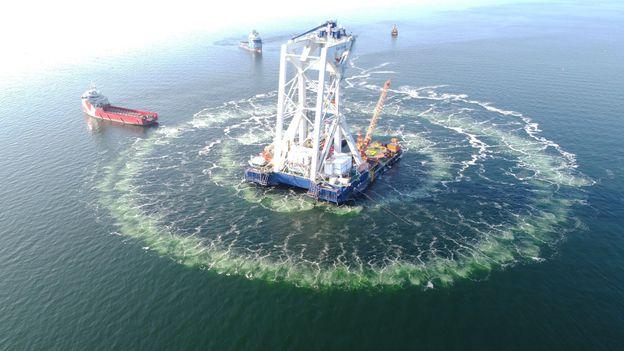Over the past decade, a curious invention has spread across Europe’s northern seas. It’s called a big bubble curtain, it works a bit like a giant jacuzzi, and it helps protect porpoises from the massive underwater noise caused by wind farm construction.
A very large, perforated hose is laid on the seabed, encircling the wind turbine site. Air is pumped through, and bubbles rise from the holes to the surface of the water, forming a noise-buffering veil.
The quirky gadget, also known as a big bubble veil, was pioneered in Germany to help protect the endangered harbour porpoise, the only cetacean species living in its North Sea and Baltic Sea. The bubble curtain was designed around the porpoise’s specific needs and traits, lowering wind farm construction noise to a threshold deemed safe for the species, based on scientific research. Its proven muffling effect may also benefit other marine mammals that are vulnerable to noise, such as seals.
The bubble curtain is now widely used by northern European countries racing to build more offshore wind farms as part of their efforts to curb CO2 emissions and fight global warming. Countries including the Netherlands, Germany, Denmark and Belgium have pledged to turn the North Sea into “the world’s largest green power plant”, aiming to jointly increase their offshore wind capacity there to 300GW by 2050. At the same time, they are under pressure to reduce the potential impact of wind farm construction noise on marine creatures, for whom sound is everything.
Harbour porpoises in the North Sea and Baltic Sea have been under severe strain from a range of human activities, researchers say (Credit: Alamy)
“Pretty much every creature in the sea relies on underwater sound. On land, most animals tend to use vision as their main sense, but in the underwater world, it’s hearing,” says Carina Juretzek, a specialist in underwater noise at Germany’s Federal Maritime and Hydrographic Agency, which regulates and approves offshore wind farms.
The small, round harbour porpoise is very sensitive to sound. It uses echolocation to navigate, communicate, hunt and avoid obstacles in often dark or murky waters, emitting ultrasonic clicks that bounce off fish or objects. Loud, human-made underwater noise – including from shipping and offshore wind farm construction – can disturb and disorient the porpoise.
Bubble curtains are based on a simple principle: sound travels faster through water than through air, because water and air have different densities. When sound waves hit the bubble curtain, they slow down, break up, and bounce against the bubbles, resulting in a loss of energy. The remaining sound that emerges on the other side of the curtain is therefore quieter.
In the North Sea, the number of wind turbines has risen from only 80 in 2002, to more than 4,000 today – and many more are planned as part of the green energy revolution. Spinning in fierce, fast sea winds, offshore turbines can produce more energy than those on land. On average, an onshore wind turbine generates around 2.5 to 3 megawatts (MW), whereas the average offshore turbine produces 3.6 MW. The scale of the latest offshore models is staggering, with heights of more than 270 metres (890ft), and each blade measuring more than 100 metres (330ft), about the length of a football pitch. A single turbine can generate enough power for a small town of 18,000 households every year. Construction of the Dogger Bank Wind Farm, a development off the coast of England, involved a ship that’s as tall as the Eiffel Tower.
As one might expect, installing these giants at sea comes with a lot of noise.
Even before the building begins, the seabed may have to be cleared of toxic World War Two bombs or mines – which happens via controlled explosions. Next, a long steel foundation, called a pile, is driven deep into the seabed with several thousand hydraulic hammer blows. This foundation then supports the turbine. The process is called pile-driving, and its sound is a source of concern to regulators and scientists who monitor the wellbeing of porpoises.
“Pile-driving noise really is one of the more intense human-made noises we can inflict on the environment,” says Juretzek. “There’s scientific evidence that this kind of noise would affect the marine environment, if it’s not reduced in some way. And that’s why Germany has decided that this pile-driving noise has to be lowered through various technical steps.”
Europe has seen a construction boom in offshore wind turbines, which are bigger and more powerful than the ones on land (Credit: Vattenfall)
Sign up to the Future Earth newsletter to get essential climate news and hopeful developments in your inbox every Tuesday from Carl Nasman. This email is currently available to non-UK readers. In the UK? Sign up for newsletters here.
At close range, pile-driving noise can cause temporary hearing loss or even permanent deafness in harbour porpoises, leaving them disoriented and unable to survive. There can also be indirect damage. A 2013 study of pile-driving during the first offshore wind farm built in the German North Sea found that the noise prompted harbour porpoises to flee the area, swimming more than 20km (12 miles) away. Harbour porpoises need to eat and hunt almost constantly to meet their energy needs. Fleeing over long distances can disrupt that vital activity and make them vulnerable to starvation. Seals may be similarly affected.
There are efforts to make construction less noisy in the first place, by using floating turbines for example, or securing the foundations through suction – though this only works if the type of sea floor, and water depth, permit it.
Other noise related to wind farm construction, such as shipping traffic, can also disturb them. In fact, before pile-driving, loud noise is used on purpose to scare them away for their own safety. There is some evidence, however, that such loud deterrents may harm the mammals’ hearing.
In response to the scientific findings, countries including Germany, Denmark and the Netherlands have introduced porpoise-shielding rules and guidelines for wind farm developers. Germany’s regulations, which researchers have called “the strictest worldwide”, include mandatory noise thresholds and the use of technologies such as the bubble curtain. According to a 2019 analysis, the German restrictions sparked “unprecedented innovation” in measures that substantially reduced noise pollution while allowing wind farm development to continue.
The invention has also seen interest beyond Europe. Hydrotechnik Lübeck, a German engineering company that developed the big bubble curtain with funding from German’s ministry of the environment, has for example partnered with a US company to deploy it in Vineyard Wind, the first large-scale offshore wind farm in the US, off the coast of Massachusetts
In Europe, data from about a decade of use suggests that the bubble curtains are remarkably effective.
Germany has measured the noise levels of every pile-driving event since 2011, capturing the sound of more than 1,000 wind turbine foundations and millions of individual hammer strokes, from a distance of 750 metres (2,460ft). Since 2014, after a development period, the sound has consistently stayed below the country’s official noise threshold.
“Our data has shown a noise reduction of over 99% [at a distance of 750 metres (2,460ft)], and in some cases, we couldn’t detect any noise at all [at a distance of some kilometres],” says Juretzek. The 99% decrease was achieved by lowering the noise by 20 decibel, through the use of the bubble curtain together with other measures, she says. Since decibel is a logarithmic scale, a 20 decibel reduction means decreasing noise by a factor of 100, therefore reducing it to 1% of its original amount. Juretzek says the best results come from combining measures such as a double layer of bubble curtains with other barriers such as a steel sleeve around the pile.
Marine mammals such as porpoises and seals are sensitive to underwater noise (Credit: Getty Images)
Hollandse Kust Zuid, a recently launched Dutch wind farm with 139 turbines, used a double bubble curtain to buffer pile-driving noise from the construction of each of the 7m-wide (23ft) foundations in 2021 and 2022.
“We applied this double big bubble curtain, that’s basically two rings of tubes that are put on the sea floor around the entire installation, at a certain distance from each other,” says Sytske van den Akker, a marine biologist working within the Environment and Sustainability unit at energy company Vattenfall, which operates Hollandse Kust Zuid. “There was air flowing into them, so each made a curtain of air bubbles.” Van den Akker and her team measured the underwater noise outside the curtain during each pile-driving, and levels consistently remained below the Dutch threshold.
“If we were afraid that we would go over the threshold, then there were some additional measures we could take,” she adds. “So for instance, sometimes the hammer energy was reduced. If you reduce it, it’s softer, and that lowers the noise.”
A 2017 study of bubble curtains used during the construction of the DanTysk wind farm in the North Sea, in which Vattenfall was also involved, found they “effectively reduced the temporary habitat loss and risk of hearing loss” for harbour porpoises.
Some experts caution that the current noise-reducing measures may not be sufficient to protect an already stressed harbour porpoise population from the wider impact of ever bigger wind farms and turbines, with more intense construction noise.
“We’re not starting with a healthy population. These animals have been living under a very high strain for decades,” says Ursula Siebert, a veterinarian and professor of zoology, and director of the Institute for Terrestrial and Aquatic Wildlife Research at the University of Veterinary Medicine in Hannover, Germany. She and her team have been closely monitoring the harbour porpoises in the Baltic and North seas for decades.
Siebert lists a range of human-made threats that have affected the population, such as entanglement in fishing gear, marine pollution, marine litter, and the loss of food sources because of fishing in their habitat. In 2019, a group of stranded porpoises in the Baltic Sea were found to have lethal blast injuries, after a controlled explosion of British mines left over from World War Two. Siebert points out that while porpoises can generally live for more than 20 years, in the Baltic Sea the average life span for females is just under four years, and in the North Sea, just under six years. “The animals in our waters die far too early,” she says.
Wind farm noise adds another potential stressor, according to Siebert – and not just during the pile-driving phase, but also potentially from ship traffic to maintain the turbines. Even the bubble curtain comes with noise: “The bubble curtain doesn’t just appear, it has to be transported there, and installed, and that has an impact of its own. If it were only 100 turbines, it wouldn’t be so bad, it would happen and then be over. But now there’s hardly a recovery phase, because there’s so much pile-driving, and so much more is planned.”
In her view, there needs to be a more honest and open debate about the state of the porpoise population, and the impact of human activity. This may also mean putting more emphasis on the need to save energy, “so we don’t push further and further into wildlife habitats” by building new wind farms.
Juretzek, at Germany’s regulating agency, says there is a difficult balance between expanding the wind farms and minimising their impact. But she also highlights that climate change poses an existential threat to marine life. “Rising temperatures in marine habitats are a really relevant point,” says Juretzek. “After all, if you look at it from a global point of view, expanding the renewable energy sector and producing sustainable energy benefits the marine environment. With that in mind, we do need to facilitate this expansion, but in a way that’s as kind to wildlife as possible.”
—
If you liked this story, sign up for The Essential List newsletter – a handpicked selection of features, videos and can’t-miss news delivered to your inbox every Friday.
Join one million Future fans by liking us on Facebook, or follow us on Twitter or Instagram.








